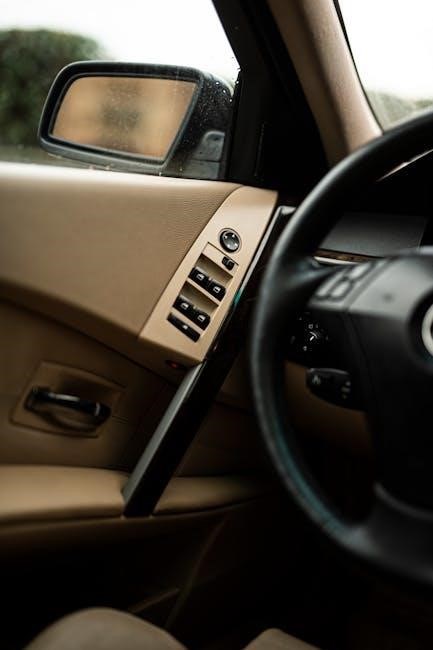The New Jersey Driver Manual is a comprehensive guide published by the NJ Motor Vehicle Commission (MVC), designed to help drivers understand traffic laws, licensing processes, and safe driving practices. Available in both English and Spanish, it serves as an essential resource for new and experienced drivers alike. The manual is regularly updated to reflect current regulations and provides detailed information on road signs, driving rules, and test preparation. Accessible online, it is a crucial tool for anyone seeking to obtain or renew a driver’s license in New Jersey.
1.1 Overview of the Manual
The New Jersey Driver Manual is a detailed guide published by the New Jersey Motor Vehicle Commission (MVC) to help drivers understand the state’s traffic laws, road rules, and safe driving practices. It is available in both English and Spanish, ensuring accessibility for all residents. The manual covers essential topics such as road signs, driving regulations, and licensing requirements. Designed for both new and experienced drivers, it serves as a valuable resource for learning and refreshing knowledge of New Jersey’s driving laws. The manual is also accessible online, making it convenient for drivers to study and prepare for tests.
1.2 Importance of the Manual for New Jersey Drivers
The New Jersey Driver Manual is a primary resource for understanding the state’s traffic laws, road rules, and licensing requirements. It is essential for new drivers to learn safe driving practices and prepare for driver’s tests. Experienced drivers can use it to refresh their knowledge and stay updated on regulations. The manual’s availability in English and Spanish ensures accessibility for all residents. By following the guidelines provided, drivers can reduce the risk of accidents and violations, making it a vital tool for maintaining road safety in New Jersey. Its comprehensive coverage makes it indispensable for anyone driving in the state.
1.3 Where to Access the NJ Drivers Manual PDF
The New Jersey Driver Manual PDF is easily accessible through the official New Jersey Motor Vehicle Commission (NJ MVC) website at www.njmvc.gov. The manual is available for free download in both English and Spanish versions, ensuring accessibility for all residents. It can be downloaded as a PDF file, allowing users to read it online or print it for convenience. Additionally, physical copies can be obtained at local MVC offices or licensed driving schools across the state. This ensures that everyone has straightforward access to the essential information needed for safe and legal driving in New Jersey.

Key Features of the NJ Drivers Manual
The NJ Drivers Manual offers interactive features like AI chat and audio options, making it accessible on mobile devices. Regularly updated, it’s available in English and Spanish.
2.1 Structure and Content
The NJ Drivers Manual is organized into clear chapters, covering licensing processes, traffic laws, and safe driving practices. Each section provides detailed explanations of road rules, signs, and safety tips.
2.2 Language Availability (English and Spanish)
The NJ Drivers Manual is available in both English and Spanish, ensuring accessibility for all residents. This bilingual availability helps non-English speakers understand driving laws, road signs, and safety practices. The Spanish version mirrors the English content, covering licensing processes, traffic rules, and test preparation. By offering the manual in two languages, New Jersey promotes inclusivity and safe driving practices across diverse communities. Both versions can be downloaded from the MVC website, making it easier for everyone to study and prepare for driver’s tests effectively. This feature underscores the state’s commitment to inclusivity and road safety for all drivers.
2.3 Regular Updates and Revisions
The NJ Drivers Manual undergoes regular updates to reflect changes in traffic laws, regulations, and driving practices. These revisions ensure the manual remains accurate and relevant, providing drivers with the most current information. Updates often include new road safety guidelines, modifications to licensing procedures, and clarifications on existing laws. The MVC reviews and revises the manual periodically to address emerging trends and improve clarity. By staying updated, the manual serves as a reliable resource for both new and experienced drivers, helping them stay informed and compliant with New Jersey’s driving regulations. This commitment to accuracy ensures safer roads and better-informed drivers.

Licensing Process in New Jersey
The NJ licensing process is detailed in the manual, guiding applicants through the MVC requirements. It outlines steps for permits, licenses, and compliance with state driving laws.
3.1 Graduated Driver License (GDL) Program
New Jersey’s Graduated Driver License (GDL) Program is designed to help new drivers gain experience and improve safety. The program applies to all new drivers, regardless of age, and requires completion of three stages. The first stage involves obtaining a learner’s permit, which allows driving under supervision. The second stage is a probationary license, restricting certain privileges like driving at night or carrying passengers. The final stage leads to a full driver’s license after meeting all requirements. The GDL Program aims to reduce accidents by gradually introducing drivers to road responsibilities, ensuring they develop essential skills and confidence behind the wheel.
3.2 Requirements for Obtaining a Learner’s Permit
To obtain a learner’s permit in New Jersey, applicants must meet specific requirements. Individuals under 17 must complete a state-approved driver education course, while those 17 or older may apply directly. A vision test and written knowledge test are mandatory. Applicants must provide proof of identity, residency, and legal presence. Minors require parental consent. The permit allows driving under supervision of a licensed driver. Applicants must hold the permit for at least six months before applying for a probationary license. These requirements ensure new drivers are prepared for the responsibilities of driving and help promote road safety.
3.3 Steps to Obtain a Full Driver’s License
After holding a learner’s permit for the required period, drivers can apply for a full license. New Jersey requires completion of the Graduated Driver License (GDL) Program, which includes practice hours and a vision test. Applicants must pass a road test to demonstrate driving skills. Upon passing, they are issued a probationary license, which restricts certain driving privileges. After meeting all requirements, drivers transition to a full, unrestricted driver’s license. This process ensures new drivers gain experience and competence before obtaining full driving privileges, promoting safety on New Jersey roads.

Road Safety and Driving Laws
The NJ Drivers Manual emphasizes right turns on red, seat belt use, and mobile phone restrictions to enhance road safety. Adhering to these laws ensures responsible driving practices and reduces accidents, fostering a safer environment for all road users in New Jersey.
4.1 Right Turn on Red Law
New Jersey’s Right Turn on Red Law allows drivers to turn right at a red light after coming to a complete stop, unless a “No Turn on Red” sign is posted. This law improves traffic flow and reduces congestion. Motorists must yield to pedestrians and oncoming traffic before turning. The NJ Drivers Manual highlights the importance of exercising caution and following all traffic signals to ensure safety. Violations may result in fines or penalties, emphasizing the need for adherence to this regulation while driving in the state.
4.2 Seat Belt and Mobile Phone Usage Laws
New Jersey enforces strict seat belt laws, requiring all drivers and passengers to wear a properly secured seat belt. Children under 8 years old or shorter than 57 inches must use a child safety seat or booster seat. Additionally, the state prohibits handheld mobile phone use while driving, including texting, emailing, or browsing the internet. Drivers under 21 are banned from using any mobile device, even hands-free. Emergency exceptions apply for reporting accidents or crimes. Violations can result in fines and penalties, emphasizing the importance of adhering to these laws to enhance road safety and reduce distractions while driving.
4.3 Speed Limits and Traffic Signals
In New Jersey, speed limits vary based on road type and location, with typical ranges of 25-35 mph in urban areas, 40-55 mph on suburban roads, and up to 65 mph on highways. Traffic signals are standardized, with red indicating stop, yellow for caution, and green for go. Turns on red are permitted unless posted otherwise. Drivers must obey all traffic signals and speed limits to ensure safety. Failure to comply can result in fines or penalties. Always be attentive to changing signals and adjust speed accordingly to maintain traffic flow and prevent accidents.

Preparing for the Driver’s Test
Study the NJ Drivers Manual to understand traffic laws, safe practices, and test requirements. Practice with online tests to build confidence and ensure readiness for the exam.
5.1 Written Knowledge Test
The written knowledge test assesses understanding of New Jersey traffic laws, road signs, and safe driving practices. It is based on the NJ Drivers Manual, which covers essential topics like right turns on red, seat belt laws, and speed limits. The test is a critical step in obtaining a learner’s permit and, eventually, a full driver’s license. To prepare, study the manual thoroughly, focusing on traffic signs, driving rules, and safety tips. Reviewing practice tests and understanding the content will help ensure success. The manual is available online as a PDF for convenient study.
5.2 Vision Test Requirements
The vision test is a mandatory part of the licensing process in New Jersey. The NJ Drivers Manual outlines the requirements, ensuring applicants meet the minimum visual acuity standards. A vision test assesses both eyes, with a requirement of 20/50 in both eyes combined for a standard driver’s license. If corrective lenses are needed, they must be worn during the test. The manual provides guidance on exemptions and accommodations for individuals with visual impairments. It also explains how the test is conducted, either at an MVC office or through an approved provider. Proper vision is critical for safe driving, as emphasized in the manual.
5.3 Road Test Preparation Tips
The NJ Drivers Manual provides detailed tips for preparing for the road test, ensuring applicants are well-equipped to demonstrate their driving skills. The manual highlights the importance of practicing common maneuvers, such as lane changes, turns, and parking, under various road conditions. It also emphasizes the need to familiarize oneself with the test route and vehicle requirements. Applicants are advised to use a properly insured and registered vehicle for the test. Additionally, the manual recommends reviewing the test criteria to avoid common mistakes, such as failing to check mirrors or signal properly. Practicing safety habits, like maintaining proper following distance, is also stressed. By following these guidelines, drivers can confidently showcase their abilities during the road test.

Commercial Driver’s Manual
The NJ Commercial Driver’s Manual provides detailed information on licensing requirements, written and road tests, and additional endorsements for commercial drivers in New Jersey.
6.1 Requirements for Commercial Drivers
Commercial drivers in New Jersey must meet specific requirements to obtain a Commercial Driver’s License (CDL). The law mandates passing written knowledge and road tests, as detailed in the manual. Eligibility includes being at least 21 years old, holding a valid medical certificate, and completing necessary documentation. The manual outlines these steps and provides study materials to prepare for the exams. It also covers additional endorsements and restrictions, ensuring drivers are fully informed about the process. By following the guidelines, applicants can efficiently navigate the licensing process and meet all regulatory standards for operating commercial vehicles in New Jersey.
6.2 Written and Road Tests for Commercial Licenses
Commercial drivers in New Jersey must pass both written knowledge and road tests to obtain a Commercial Driver’s License (CDL). The written test covers federal and state regulations, safety protocols, and vehicle-specific knowledge. The road test assesses driving skills, including vehicle inspection, basic maneuvers, and on-road performance. The NJ Drivers Manual provides detailed study materials to help applicants prepare for these exams. It outlines the format and content of the tests, ensuring drivers are well-equipped to demonstrate their understanding of commercial driving requirements. Passing both tests is mandatory to qualify for a CDL and operate commercial vehicles legally in New Jersey.
6.3 Additional Endorsements and Restrictions
Commercial drivers in New Jersey may need additional endorsements to operate specialized vehicles, such as HAZMAT, Tank, or Doubles/Triples trailers. These endorsements require additional testing and background checks. Restrictions, such as age limits or medical certifications, may also apply. The NJ Drivers Manual details these requirements, ensuring drivers understand the qualifications for each endorsement and restriction. It also outlines the process for obtaining endorsements and the consequences of violating restrictions. The manual serves as a key resource for commercial drivers seeking to expand their licensing capabilities while adhering to state and federal regulations. Proper compliance ensures safe and legal operation of commercial vehicles.

Driver’s Manual and Traffic Laws
The NJ Drivers Manual explains traffic laws, covering right turns on red and seat belt requirements, promoting safe practices and outlining penalties for violations to ensure compliance.
7.1 Understanding Traffic Signs and Signals
The NJ Drivers Manual emphasizes the importance of recognizing and obeying traffic signs and signals, which are crucial for safe and lawful driving. Regulatory signs, such as speed limit and stop signs, inform drivers of specific laws and requirements. Warning signs alert drivers to potential hazards, like curves or pedestrian crossings, while guide signs provide directional information. Traffic signals, including red, yellow, and green lights, control the flow of traffic and ensure orderly movement at intersections. The manual includes detailed descriptions and visuals to help drivers identify and interpret these signs and signals accurately, promoting safe navigation of New Jersey roads.
7.2 Safe Driving Practices
The NJ Drivers Manual highlights essential safe driving practices to ensure road safety. Defensive driving is emphasized, encouraging awareness of surroundings and anticipation of other drivers’ actions. Maintaining a safe following distance and adjusting speed according to road conditions are stressed. Sharing the road with pedestrians, cyclists, and large vehicles requires courtesy and caution. Avoiding distractions, such as using mobile devices, is a key focus. The manual also underscores the importance of wearing seat belts and adhering to speed limits. By following these guidelines, drivers can significantly reduce the risk of accidents and contribute to a safer driving environment in New Jersey.
7.3 Consequences of Violating Traffic Laws
Violating traffic laws in New Jersey can result in serious consequences, including fines, license suspension, or even revocation. Accumulating penalty points on your driving record can lead to increased insurance rates and loss of driving privileges. Repeated offenses may require mandatory driver improvement courses or court appearances. Additionally, certain violations, such as reckless driving or speeding, can escalate to criminal charges. The NJ Drivers Manual emphasizes the importance of complying with traffic laws to avoid these repercussions and ensure public safety. Understanding and adhering to these regulations is crucial for maintaining a clean driving record and preventing legal complications.

Benefits of Using the NJ Drivers Manual
The NJ Drivers Manual offers a comprehensive guide to driving laws, serves as a valuable study tool for license tests, and provides a resource for experienced drivers to refresh their knowledge. Its accessibility on mobile devices ensures convenience for all users.
8.1 Comprehensive Guide to Driving Laws
The NJ Drivers Manual provides an extensive overview of driving laws, ensuring drivers are well-informed about traffic rules, road signs, and safe practices. It covers essential topics such as right turns on red, seat belt requirements, and mobile phone usage. Additionally, the manual details speed limits, traffic signals, and the consequences of violating these laws. This comprehensive guide helps drivers navigate New Jersey’s roads confidently by understanding their legal responsibilities and promoting safe driving habits. Regular updates ensure the information remains current and relevant to changing traffic regulations.
8.2 Study Material for License Tests
The NJ Drivers Manual serves as a primary study resource for individuals preparing for their driver’s license tests. It contains detailed information on road rules, traffic signs, and safe driving practices, aligning with the content of the written knowledge test. The manual includes practice questions and guides applicants through the licensing process, ensuring they are well-prepared for both the written and road tests. Its clear and concise format makes it an invaluable tool for learners, while experienced drivers can use it to refresh their knowledge of New Jersey’s driving laws and regulations.

8.3 Resource for Experienced Drivers
The NJ Drivers Manual is not only for new drivers; it also serves as a valuable resource for experienced drivers seeking to refresh their knowledge or adapt to updated traffic laws. The manual provides a comprehensive review of driving regulations, ensuring seasoned drivers stay informed about changes in road rules, safety practices, and licensing requirements; Additionally, its interactive features, such as audio study options and AI chat, offer convenient ways for experienced drivers to quickly review specific topics or clarify doubts. This makes the manual a lifelong resource for maintaining and improving driving skills in New Jersey.

Interactive and Digital Features
The NJ Drivers Manual PDF offers interactive features like audio study options, AI chat for instant answers, and accessibility on mobile devices, enhancing learning convenience and engagement for all users.
9.1 Audio Study Option
The NJ Drivers Manual PDF includes an audio study option, allowing users to listen to the manual’s content. This feature is particularly beneficial for auditory learners and those who prefer multitasking. By enabling users to absorb information while commuting or during breaks, it enhances flexibility in study routines. The audio version covers all sections, from road signs to driving laws, ensuring comprehensive preparation for driver’s tests. This innovative feature aligns with modern learning preferences, making the manual more accessible and user-friendly for a diverse audience.
9.2 AI Chat for Instant Answers
The NJ Drivers Manual PDF now features an AI chat option for instant answers, revolutionizing how users interact with the manual. This advanced tool provides immediate responses to questions about driving laws, road signs, and licensing requirements. By leveraging AI technology, the chat offers personalized assistance, helping users clarify doubts and deepen their understanding of the material. Accessible 24/7, it supports learners in real-time, making study sessions more efficient and engaging. This innovative feature ensures that users can quickly find the information they need, enhancing their overall learning experience and test preparation. It exemplifies how technology is transforming driver education in New Jersey.
9.3 Accessibility on Mobile Devices
The NJ Drivers Manual PDF is fully accessible on mobile devices, allowing users to study anytime, anywhere. The manual is optimized for smartphones and tablets, ensuring a seamless reading experience. Features like zoom, night mode, and easy navigation make it convenient for learners to review driving laws and safety tips on the go. The mobile-friendly design enables users to access the manual without needing a computer, making it a flexible study tool. This accessibility ensures that everyone can prepare for their driver’s test or refresh their knowledge of New Jersey’s traffic rules, regardless of their location or device preference.
10.1 Final Tips for Using the Manual Effectively
The NJ Drivers Manual PDF is a vital resource for understanding driving laws and safe practices. Accessible in PDF and mobile formats, it ensures easy study. Mastery of its content is key to becoming a confident and informed driver in New Jersey.
To maximize the benefits of the NJ Drivers Manual PDF, utilize its interactive features like audio study and AI chat for a personalized learning experience. Regularly review the manual to stay updated on driving laws and safe practices. Focus on understanding traffic signs, signals, and regulations to enhance your knowledge. Practice with sample tests to assess your readiness for the actual exam. For optimal convenience, access the manual on your mobile device. Consistent study and adherence to the guidelines will ensure you become a well-informed and confident driver in New Jersey. Visit the NJ MVC website for the latest updates and resources.
10.2 Encouragement to Practice and Stay Informed
Consistent practice and staying informed are key to mastering New Jersey’s driving laws and regulations. Use the NJ Drivers Manual PDF as a primary study resource, focusing on understanding traffic signs, signals, and safe driving techniques. Regularly review the manual to stay updated on any changes in traffic laws or licensing requirements. Additionally, take advantage of online practice tests to reinforce your knowledge. By combining theoretical learning with practical experience, you’ll build confidence and ensure a safe driving experience. Remember, informed drivers are safer drivers, so keep exploring and refining your skills with the manual’s guidance.
